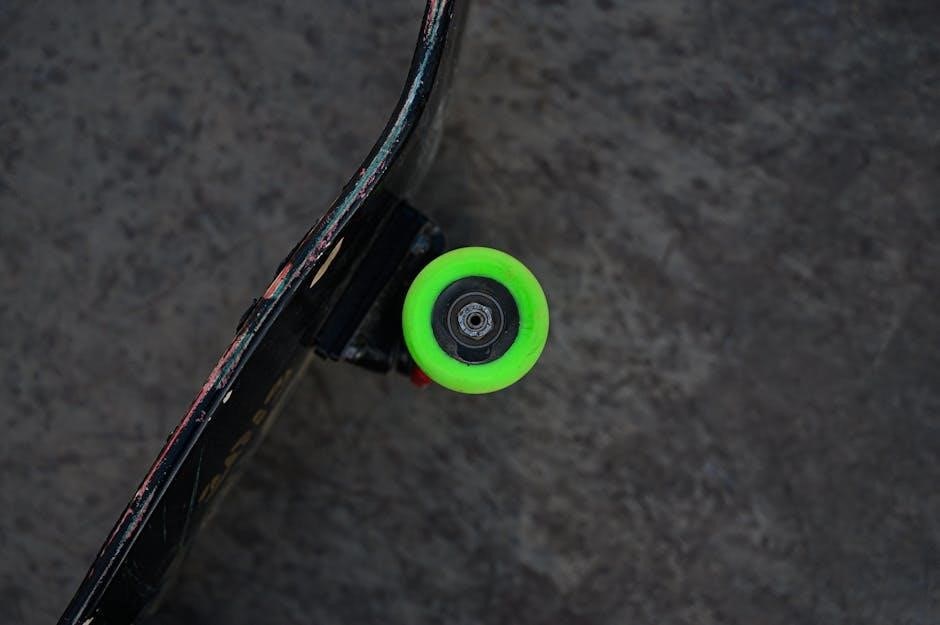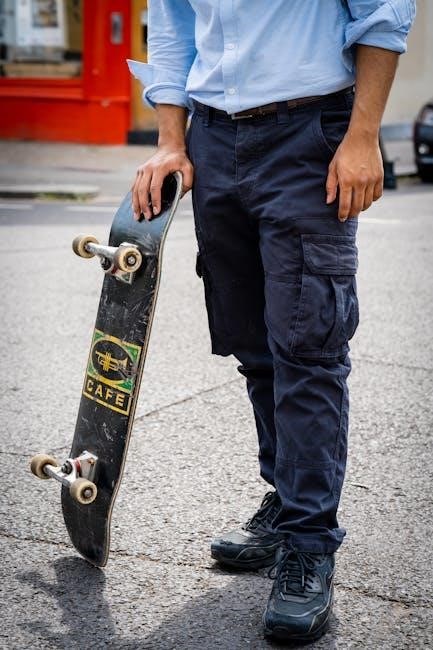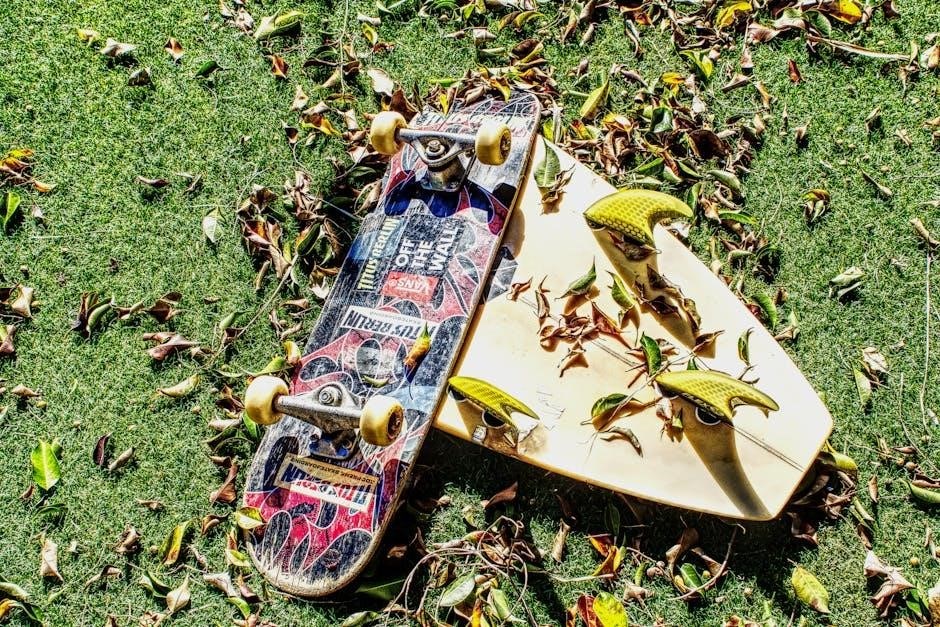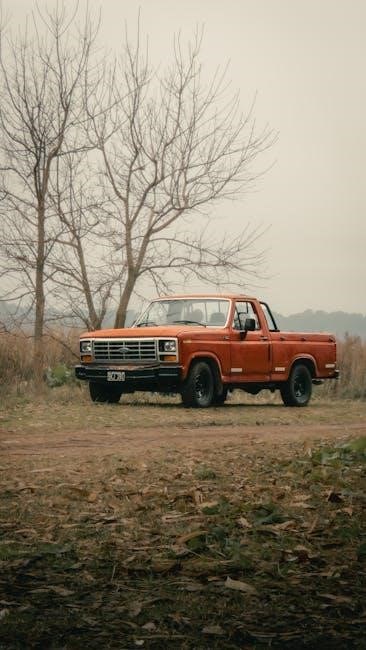Skateboard trucks are T-shaped metal components that connect the deck to the wheels, enabling turning and maneuverability․ Choosing the right truck size is crucial for stability, performance, and compatibility with your deck width, ensuring optimal skating experience and control․
1․1 What Are Skateboard Trucks?
Skateboard trucks are T-shaped metal components that attach the deck to the wheels, enabling turning and maneuverability․ They consist of a hanger, baseplate, and axle, housing the bearings and wheels․ Trucks play a critical role in a skateboard’s functionality, affecting stability, responsiveness, and overall performance․ Their durability and compatibility with deck width are essential for optimal skating experiences․
1․2 Importance of Choosing the Right Truck Size
Choosing the right truck size is essential for a skateboard’s stability, responsiveness, and overall performance․ Properly sized trucks ensure optimal compatibility with the deck width, improving maneuverability and control․ Incorrect sizing can lead to poor performance, uneven wear, or difficulty in handling the board․ The right truck size enhances skating efficiency and ensures a smoother, more enjoyable ride, making it a critical factor in your setup’s success․

Understanding Truck Size and Deck Compatibility
Truck size directly impacts your skateboard’s performance and stability, making proper deck compatibility crucial․ The right fit ensures optimal maneuverability and responsiveness, aligning with manufacturers’ guidelines for ideal setups․
2․1 How Truck Size Relates to Deck Width
Truck size is directly determined by the width of your skateboard deck․ A truck that is too narrow may cause instability, while one too wide can restrict turning․ Properly matching truck size to deck width ensures optimal performance, stability, and control․ For example, a 7․75″ deck pairs with Independent 129 trucks, while an 8․00″ deck aligns with Independent 139 trucks, maintaining balance and responsiveness for a smoother skateboarding experience․
2․2 Why Proper Fit Matters for Performance
A proper fit between trucks and deck width is essential for optimal performance․ Ill-fitting trucks can lead to poor stability, reduced maneuverability, and uneven wear․ When trucks are too wide, they may cause the wheels to protrude, increasing the risk of wheel bite․ Conversely, trucks that are too narrow can make the board unstable․ Properly sized trucks ensure smooth turning, better control, and a more responsive skating experience, making them a critical component of your setup․

Skateboard Truck Size Chart
This section provides a detailed guide to truck sizes, including measurements and compatibility with deck widths․ It helps skaters choose the right trucks for their setup, ensuring optimal performance and stability․
3․1 Standard Truck Sizes and Measurements
Standard truck sizes range from 7․6″ to 8․25″ in axle width, corresponding to deck widths from 7․25″ to 8․5″․ Common sizes include 129mm, 139mm, and 144mm, ensuring compatibility with various deck widths․ Proper fitment enhances stability and maneuverability, while incorrect sizing can lead to poor performance or damage․ Always match truck width to deck size for optimal skating experience and control․
3․2 Popular Brands and Their Size Specifications
Leading brands like Independent, Thunder, and Venture offer standardized truck sizes․ Independent trucks range from 129mm to 144mm, fitting decks 7․25″ to 8․5″․ Thunder trucks include sizes like 145mm and 147mm, while Venture offers 5․0 to 5․6 sizes․ Krux and Ace trucks also provide specific fits, ensuring compatibility with various deck widths․ Each brand tailors its sizing to meet skaters’ needs, making it easier to find the perfect match for your setup․
3․3 Size Recommendations for Different Deck Widths
Truck size should align with deck width for optimal performance․ Decks under 7․75″ pair with trucks like Independent 129 or Krux 7․6․ For 7․75″-8․25″ decks, Independent 139, Thunder 147, or Ace 22 are ideal․ Wider decks (8․25″-8․75″) match with Independent 144, Thunder 148, or Krux 8․25․ Always ensure trucks are proportional to your deck for stability, control, and smooth maneuverability, regardless of your skating style or preference․

Factors Influencing Truck Size Selection
Deck width, skating style, and wheel compatibility are key factors in choosing truck size․ Proper fit ensures stability, responsiveness, and a seamless skating experience for all riders․
4․1 Deck Width and Its Role in Choosing Trucks
Deck width is the primary factor in selecting truck size, as it ensures proper alignment and stability․ A deck width of less than 7․75″ pairs with smaller trucks like Independent 129, while wider decks (8․00″ or more) require larger trucks such as Independent 139․ Matching truck size to deck width enhances responsiveness, control, and overall skating performance, making it essential for a balanced setup․
4․2 Skater’s Style and Preference
A skater’s style and preference significantly influence truck selection․ Street skaters may prefer lighter, more responsive trucks, while cruisers or transition skaters might opt for wider, more stable setups․ Personal comfort and skating habits also play a role, as some riders prioritize tighter turns, while others value speed and durability․ Ultimately, truck choice should align with how and where the skater intends to ride, ensuring a personalized and enjoyable experience․
4․3 Wheel Size and Compatibility
Wheel size significantly impacts truck compatibility, as larger wheels require wider trucks to prevent wheel bite and ensure smooth performance․ Smaller wheels suit narrower trucks, optimizing maneuverability․ Compatibility ensures proper clearance and stability, crucial for various skating styles․ Always match wheel size to truck width for optimal functionality and to avoid issues like uneven wear or restricted movement․
Popular Skateboard Truck Brands
Top brands like Independent, Thunder, and Venture offer high-quality trucks with precise size guides, ensuring compatibility with various deck widths for optimal performance and durability․
5․1 Independent Trucks Size Guide
Independent Trucks offers a wide range of sizes to fit various deck widths․ Their size guide includes popular models like 129mm, 139mm, and 144mm, with axle widths matching deck sizes for optimal stability․ These trucks are known for durability and responsiveness, making them a favorite among skaters․ The size chart ensures compatibility, providing a smooth ride and precise control for skaters of all levels and styles․
5․2 Thunder Trucks Size Chart
Thunder Trucks offers a detailed size chart to ensure compatibility with various deck widths․ Popular sizes include 145mm, 147mm, and 148mm, each designed for specific deck ranges․ For example, the 145mm trucks suit decks around 8;0 inches, while the 148mm fits wider decks up to 8․5 inches․ Thunder Trucks are known for their strength and responsiveness, making them a top choice for skaters seeking durability and precise control․
5․3 Venture Trucks Size Recommendations
Venture Trucks offers a size range to fit various deck widths, ensuring optimal performance․ Their 5․0 size suits decks between 7․75″ and 8․00″, while the 5․2 size fits 8․00″ to 8․25″ decks․ The 5․6 size is recommended for wider decks, up to 8․50″․ Venture Trucks are known for durability and responsiveness, making them a reliable choice for skaters seeking stability and smooth turning capabilities across different skating styles․
5․4 Krux Trucks Size Guide
Krux Trucks offers a variety of sizes to match different deck widths, ensuring a precise fit․ Their axle widths range from 7․6″ to 8․25″, with recommendations for deck sizes between 7․25″ and 8․50″․ Krux Trucks are known for their durability and smooth grind performance, making them a popular choice among skaters․ Their size guide provides clear compatibility options, ensuring optimal stability and responsiveness for various skating styles and preferences․
5․5 Ace Trucks Size Chart
Ace Trucks offers a size chart with axle widths ranging from 7․6″ to 8․25″, designed to fit decks between 7․25″ and 8․50″․ Their trucks are known for strength and stability, making them ideal for street or transition skating․ With a focus on durability and smooth performance, Ace Trucks provide a reliable choice for skaters seeking consistent grind and turning capabilities, ensuring a balanced setup for various skating styles and preferences․
How to Measure Skateboard Trucks
Measuring skateboard trucks involves determining the axle width, which matches the deck width for proper fit․ Use a ruler to measure from axle tip to axle tip accurately․
6․1 Understanding Axle Width vs․ Hanger Width
Axle width measures the distance between the truck’s axle tips and must match the skateboard deck width for proper fit․ Hanger width refers to the width of the hanger itself․ While axle width is crucial for compatibility, hanger width impacts turning performance․ Mixing up these measurements can lead to improper installation and affect the board’s stability․ Always measure axle width when selecting trucks for your setup․
6․2 How to Measure Your Current Trucks
To measure your skateboard trucks, start by placing the truck on a flat surface․ Measure the axle width, which is the distance between the two axle tips․ Use a ruler or caliper for accuracy․ Next, measure the hanger width by gauging the distance between the inner sides of the hanger․ These measurements will help determine compatibility with your deck and wheels․ Accurate sizing ensures proper fit and optimal performance․
Choosing the Right Truck Size for Your Setup
Choosing the right truck size involves matching your deck width, considering your skating style, and ensuring compatibility with your wheels for optimal performance and stability․
7․1 Matching Trucks to Deck Width
Matching trucks to your deck width ensures optimal stability and control․ A 7․75″ deck pairs with Independent 129 trucks, while an 8․00″ deck fits Independent 139․ Proper sizing prevents issues like uneven grinds and wheel bite, ensuring smooth performance and alignment with your skating style․
7․2 Considering Personal Skateboarding Style
Your skateboarding style plays a significant role in choosing the right truck size․ Street skaters may prefer narrower trucks for better maneuverability, while cruisers might opt for wider trucks for stability․ Understanding your skating preferences helps in selecting trucks that enhance performance, control, and comfort, ensuring a more enjoyable and tailored experience on the board․

Common Mistakes to Avoid
Choosing trucks too wide or narrow for your deck and ignoring wheel compatibility are common mistakes․ Ensure proper fitment for optimal performance and stability․
8․1 Choosing Trucks Too Wide or Too Narrow
Choosing trucks that are too wide or too narrow for your deck can lead to poor stability and performance․ Trucks that are too wide may cause the wheels to stick out, affecting grindability, while trucks that are too narrow can make the board unstable․ Properly matching truck width to deck size ensures optimal control and maneuverability, preventing these issues and enhancing your skating experience․
8․2 Ignoring Wheel Compatibility
Ignoring wheel compatibility can lead to improper fit and performance issues․ Wheels that are too large or small for the trucks may cause instability or affect how the board handles․ Ensuring that your wheels align with your truck size is essential for optimal performance, stability, and maneuverability․ Proper compatibility enhances control and ensures a smoother skating experience, making it a critical factor in your setup․
Installation and Setup Tips
Proper installation ensures optimal performance․ Align trucks with deck bolts, use risers for larger wheels, and tighten kingpins firmly but avoid overtightening to prevent damage․
9․1 How to Install Trucks on Your Deck
To install trucks, align the truck baseplate with the deck’s mounting holes, ensuring proper alignment․ Insert the bolts through the deck and tighten them evenly using a skate tool or wrench․ Make sure the trucks are centered and the axle is facing outward․ If using risers, place them between the deck and trucks to accommodate larger wheels․ Tighten all bolts firmly but avoid overtightening, as this can damage the deck or trucks;
9․2 Adjusting Trucks for Optimal Performance
Adjust the kingpin nut to achieve the desired tightness for turning and stability․ Tightening it improves stability but reduces maneuverability, while loosening enhances turning but may compromise stability․ Use a skate tool or wrench to make adjustments․ Ensure the trucks are not too loose to avoid speed wobbles or too tight to restrict movement․ Test the feel and adjust in small increments until the performance matches your skating style and preferences․
Maintenance and Upkeep
Regularly clean your trucks to remove dirt and grime, ensuring smooth operation․ Lubricate the axles and pivot cups to maintain optimal performance and longevity․ Inspect for wear and tear, replacing components when necessary to prevent damage and ensure safety․
10․1 Cleaning and Lubricating Trucks
Regular cleaning and lubrication are essential for maintaining skateboard trucks․ Disassemble the trucks and clean all parts with a soft brush and mild solvent to remove dirt and grime․ Rinse thoroughly and dry before reassembly․ Apply silicone-based lubricant to the axles and pivot cups to ensure smooth turning and reduce friction․ Proper maintenance extends the lifespan of your trucks and keeps your skateboard performing optimally․
10․2 When to Replace Your Trucks
Replace your skateboard trucks when they show significant wear, such as rust, excessive play, or bent axles․ If the trucks no longer turn smoothly or feel unstable, it’s time for new ones․ Damaged kingpins, worn-out bushings, or stripped screws are also signs of needing replacement․ Regularly inspecting your trucks ensures safety and optimal performance․ Replace them every 1-2 years or sooner if you skate frequently or in harsh conditions․
Troubleshooting Common Issues
Loose or tight trucks can affect performance․ Tightening or loosening the kingpin may resolve the issue․ Wobbling often indicates improper installation or worn parts․ Inspect and replace damaged components promptly to ensure stability and safety while skating․ Regular maintenance helps prevent these issues from arising․ Addressing problems early avoids further damage to your setup․ Always carry a toolkit for quick adjustments․
11․1 Fixing Loose or Tight Trucks
Loose trucks can cause instability, while tight trucks may restrict turning․ To fix, use a skate tool or wrench to adjust the kingpin nut․ For loose trucks, tighten the nut in small increments until the trucks feel stable․ For tight trucks, loosen the nut slightly until they move smoothly․ Ensure the trucks are not over-tightened, as this can damage the bushings․ Proper adjustment ensures better control and maneuverability․ Regularly check and adjust your trucks for optimal performance․
11․2 Addressing Uneven Grind
An uneven grind can result from misaligned trucks or uneven wear․ Check if one truck sits lower than the other and adjust the kingpin nut for balance․ Inspect the bushings for wear and replace them if necessary․ Ensure your trucks are properly aligned with the deck’s width, as mismatched sizes can cause uneven performance․ Regularly cleaning and lubricating the trucks can also help maintain even grinding and smooth transitions during tricks․
Choosing the right skateboard truck size is essential for optimal performance and stability․ Always match your trucks to your deck width and skating style for the best experience․
12․1 Recap of Key Points
Choosing the right skateboard truck size is crucial for performance and stability․ Match trucks to your deck width and skating style for optimal control․ Proper fit ensures better maneuverability and responsiveness․ Deck width, wheel size, and personal preference are key factors․ Using the correct size enhances stability and prevents issues like uneven grinds․ Always refer to size charts for popular brands like Independent, Thunder, and Venture․ Proper installation and maintenance also ensure longevity and optimal performance․
12․2 Final Tips for Choosing the Right Trucks
Always match truck size to your deck width for proper fit and stability․ Consider your skating style for optimal responsiveness․ Ensure wheel compatibility to avoid performance issues․ Double-check size charts for popular brands like Independent or Thunder․ Proper installation and regular tightening are essential․ Clean and lubricate trucks regularly for longevity․ Replace worn-out parts promptly to maintain performance․ Prioritize quality and durability for a smooth, enjoyable skateboarding experience․
Frequently Asked Questions
What happens if my trucks are too small? Can I use larger trucks for stability? How do I know if my trucks are worn out?
13․1 What Happens If My Trucks Are Too Small?
If your skateboard trucks are too small, they may cause instability and poor performance․ The wheels might stick out beyond the deck, leading to uneven grind and reduced control․ This mismatch can also result in premature wear on both the trucks and the deck․ Ensuring proper truck size is essential for optimal skating experience and safety․
- Poor stability and maneuverability․
- Increased risk of wheel bite․
- Uneven wear on components․
Always refer to a size guide to avoid these issues․
13․2 Can I Use Larger Trucks for Stability?
Larger trucks can provide added stability, especially for cruisers or downhill skating․ However, they may feel less responsive and harder to turn․ Oversized trucks can also cause wheel bite or uneven wear if not paired correctly with your deck and wheels․ Always ensure proper compatibility and balance between stability and maneuverability for your skating style․
- Larger trucks enhance stability at higher speeds․
- They may reduce agility for street or technical skating․
- Proper sizing is key to avoiding performance issues․
Consult a size guide for the best fit․
13․3 How Do I Know If My Trucks Are Worn Out?
Your trucks may be worn out if they show excessive play in the axle, uneven wear on the hanger, or stripped kingpin bolts․ If they feel unstable or fail to respond smoothly during turns, it’s time to inspect them closely․ Regularly check for rust, bent axles, or worn-out bushings, as these signs indicate wear․ Replace them if performance is compromised to maintain your skateboard’s functionality and safety;
- Excessive axle play or instability․
- Visible wear or deformation of metal parts․
- Difficulty in turning or adjusting trucks․
Replace worn-out trucks to ensure optimal performance and safety․
